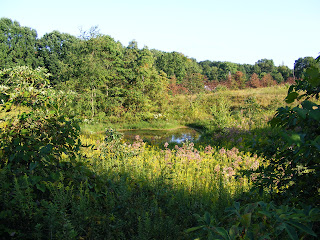
If you zoom in on the picture and look carefully, you can see two tiny legs forming on the largest tadpole. This is nearly the end of a long story which I'll try to relate.
Late in the spring we were entertained each night for over a week by the sound of frogs. With a little study I learned that they were tree frogs. The closest large trees to the house are about 50 feet away so we were surprised to hear the frogs coming closer to the building each night.
Next to the building, under the eaves, along with lots of plastic buckets I've been using to catch rain water, were two stock troughs, each about 4 feet long and 2 feet across. They had once been used as planters and had some holes punched in their bottoms, but I had lined them with fragments of billboard tarps and they hold water perfectly.
One day, while using some of the rainwater from a trough, I found a small frog in the folds of the tarp. The next day, believe it or not, a frog was nestled in the bracket that supports the satellite TV dish. (Satellite is the only option this far out of town. It's too hilly for antenna reception.) Since s/he was about 6 feet above ground, and the wall is HardiBoard (cement board) panels, it wasn't hard to conclude this had to be a climbing tree frog.
By now the nightly chirping was so close to the house you could tell, through the downstairs bedroom window, that a frog was within reach right under it. The next night there seemed to be two frogs close by, and soon a third, though this one sounded different.
The next morning I found a large mass of frog eggs in one of the troughs. One could already see tiny, tiny tadpoles in most of the eggs. The eggs had not been there the day before. Virtually all of them hatched, and soon we had about 500 tiny tadpoles in the trough.
I feared there wasn't enough surface area or water volume to support them all so I scooped roughly half of them into the other trough. After more studying we learned that tadpoles are vegetarians, eating only what vegetable matter they find in their water. (Some say they also east larva, but this must only be after they have nearly completed their metamorphoses, because they are sharing the tank with larva as big as they are.)
This was not good news. First, I had hoped they would eliminate the larvae sharing their space. Second, there is no vegetation in the troughs except some algae, and not much of that. Finally, with no nourishment, the troughs simply can't be expected to support them all.
Consequently, I began a program of transferring them, 50 to a hundred at a time, to the pond. I had no idea if they would survive the change, but what alternative was there? I was able to give a few dozen away to a friend with a small pond, but the rest were going to have to move.
Over the next few weeks I took almost all of them to the pond. It is a different environment: the water is usually muddy and there is at least one large snapping turtle in it, but there is also some grassy vegetation to provide cover, and plenty of vegetable matter.
The picture above is the last bucket of tadpoles to be moved. After a few months they still have not matured much in the troughs, and cooler weather is coming. If they were to make it this season, they had to move.
We hope this effort has allowed a lot more of them to grow big enough to swim away from the turtle than if they had been laid in the pond to begin with. I hope we'll hear from many of them again next spring.
By the way, I tried to find help raising the tadpoles from the Indiana Department of Natural Resources, the Indianapolis Zoo and online sources including two herpetological societies. There are plenty of pictures online, but not one had useful advice. In fact, some said "Let us know how you make out."
Here's what the pond looks like now from up the hill a bit.







